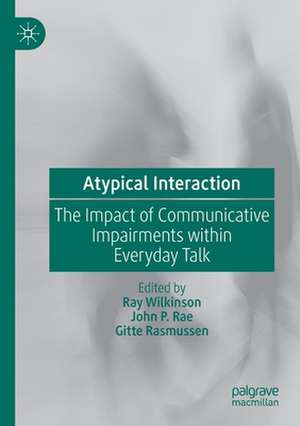Atypical Interaction: The Impact of Communicative Impairments within Everyday Talk
Editat de RAY WILKINSON, John P. Rae, Gitte Rasmussenen Limba Engleză Paperback – 26 aug 2021
With fourteen empirical chapters from leading scholars in the field and an introductory chapter which provides a background to conversation analysis and its application to the study of atypical interactions, the collection will be an invaluable resource for students, practitioners such as speech and language therapists, and researchers with an interest in human communication, communication diversity and disorder.
| Toate formatele și edițiile | Preț | Express |
|---|---|---|
| Paperback (1) | 1292.70 lei 6-8 săpt. | |
| Springer International Publishing – 26 aug 2021 | 1292.70 lei 6-8 săpt. | |
| Hardback (1) | 1297.73 lei 3-5 săpt. | |
| Springer International Publishing – 20 apr 2020 | 1297.73 lei 3-5 săpt. |
Preț: 1292.70 lei
Preț vechi: 1360.74 lei
-5% Nou
Puncte Express: 1939
Preț estimativ în valută:
247.39€ • 257.32$ • 204.23£
247.39€ • 257.32$ • 204.23£
Carte tipărită la comandă
Livrare economică 15-29 aprilie
Preluare comenzi: 021 569.72.76
Specificații
ISBN-13: 9783030288013
ISBN-10: 3030288013
Pagini: 470
Ilustrații: XXIII, 470 p. 168 illus., 9 illus. in color.
Dimensiuni: 148 x 210 mm
Greutate: 0.65 kg
Ediția:1st ed. 2020
Editura: Springer International Publishing
Colecția Palgrave Macmillan
Locul publicării:Cham, Switzerland
ISBN-10: 3030288013
Pagini: 470
Ilustrații: XXIII, 470 p. 168 illus., 9 illus. in color.
Dimensiuni: 148 x 210 mm
Greutate: 0.65 kg
Ediția:1st ed. 2020
Editura: Springer International Publishing
Colecția Palgrave Macmillan
Locul publicării:Cham, Switzerland
Cuprins
Chapter 1 Atypical Interaction: An Introduction; Ray Wilkinson, John Rae & Gitte Rasmussen.- Chapter 2 Sequence and Consequence: Transposing Responsive Actions Into Provocations in Forensic and Clinical Encounters Involving Youths with Autism; Douglas W. Maynard, Jason Turowetz.- Chapter 3 Making and taking opportunites for co-participation in an interaction between a boy with autism spectrum disorder and his father; John P. Rae, Monica Ramey.- Chapter 4 Difficulties facing people with intellectual disability in conversation: initiation, co-ordination, and the problem of asymmetric competence; Chris Walton, Charles Antaki, and W.M.L. Finlay.- Chapter 5 Does Atypicality Entail Impairment? Tracing the Use of a Cohesive Marker in the Interactions of an Individual with Schizophrenia; Lisa Mikesell.- Chapter 6 Singing as a resource in conversations involving persons with dementia; Gitte Rasmussen.- Chapter 7 Dementia in Conversation: Observations from Triadic Memory Clinic Interactions; Christopher Elsey.- Chapter 7 Dementia in Conversation: Observations from Triadic Memory Clinic Interactions; Christopher Elsey.- Chapter 9 Repair organization in linguistically asymmetric interaction: comparing child-parent conversations and conversations involving speakers with aphasia; Minna Laakso.- Chapter 10 Increasing learner authority in the classrooms of children with speech language and communication needs; Julie Radford.- Chapter 11 ‘My own space in this world’: Stammering, telephone calls, and the progressivity and permeability of turns-at-talk; Ray Wilkinson, Sarah Morris.- Chapter 12 Person reference as a trouble source in dysarthric talk-in-interaction; Steven Bloch, Charlotta Saldert.- Chapter 13 How can the ‘autonomous speaker‘ survive in atypical interaction? The case of anarthria and aphasia; Peter Auer, Angelika Bauer and Ina Hörmeyer.- Chapter 14 Practices of negotiating responsibility for troubles in interaction involving people with hearing impairment in Australia; Katie Ekberg, Louise Hickson, and Christopher Lind.- Chapter 15 Resources for repair initiation in a Swiss German classroom and a Swiss German Sign Language classroom; Simone Girard-Groeber.
Notă biografică
Ray Wilkinson is Professor of Human Communication at the University of Sheffield, UK. He has a clinical background in speech and language therapy. His research interests focus on everyday social interaction, in particular where participants do not have the communicative resources available to neurotypical adult native language speakers.
John P. Rae is Reader in Psychology in the Department of Psychology at the University of Roehampton, UK. He has a BA in Philosophy and Psychology and a PhD in Psychology, both from the University of Leeds. He is interested in how people use talk and visible action in social interaction.
Gitte Rasmussen is Professor of Social Interaction in the Department of Language and Communication at the University of Southern Denmark. Her research interests concern how people organize social activities and interactions and how they design their talk and visual actions in accordance with their assumptions about each other’s knowledge.
Caracteristici
Presents new findings on how communication impairments impact on everyday social interactions
Offers unique coverage of both acquired and developmental forms of atypical interaction
Highlights not only the communication difficulties but also the competences and novel forms of communication displayed by atypical communicators
Offers unique coverage of both acquired and developmental forms of atypical interaction
Highlights not only the communication difficulties but also the competences and novel forms of communication displayed by atypical communicators
